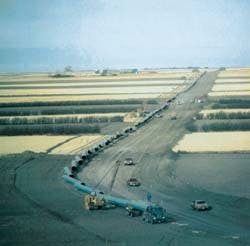GIS-based process helps TransCanada select best route for expansion line
David Montemurro, Steve Barnett
TransCanada PipeLines Ltd.
CalgaryTony Gale
Earth Information Systems Corp.
Austin, Tex
TransCanada PipeLines Ltd.'s contractors work on laying a 48-in., fusion-bonded-epoxy coated pipeline during 1997 summer construction in the Canadian prairies. Since the first gas pipeline of TCPL's main line system was built in the late 1950s, six lines varying between 30 in. and 48 in. have been completed and are operating.
- Landsat imagery and GIS summary layer show Great Sand Hills, Sask., home to endangered species and an area that poses significant challenges for environmental restoration (Fig. 3 [10,269 bytes]).
- The route output, shown in red, is the result of GIS-based automated selection of alternatives (Fig. 5 [19,975 bytes]).
The process had been benchmarked against TCPL's standard route-planning approach for the selection of route alternatives (Fig. 1 [83,025 bytes]) and was chosen to improve the speed and consistency of route selection, which would be used for both domestic and international TCPL pipeline expansion and new transmission ventures.
GIS technology combines a centralized data base with earth imagery and spatial analysis. It is used to unify project processes including environmental characterization and project-team decision making.
When these elements are integrated, a clearly defined, defensible approach to route planning and selection is created. The approach results in improved decision-making, identification of critical areas, better communication with government and public interests, and increased coordination and control for internal project management.
The proposed western Canadian expansion project is the construction of a seventh line to expand the existing TCPL main line system. The proposed line would run from Empress at the Alberta-Saskatchewan border to Emerson at the Manitoba-North Dakota (U.S.) border, forming part of TCPL's east-west link between Canadian and U.S. markets.
The planned 1,000-km (625 mile), 48-in., 1,000-psi line would cost an estimated US$950 million.
Pipeline route selection is a strategic component of a transmission company's expansion activities. The selection process begins with a feasibility study and an assessment of the alternative routes to link source to market.
The selected route can significantly affect the success or failure of a project, depending on its public acceptance, economics, and construction impact.
Critical issues affecting route selection are societal risk, environmental impact, and engineering and operational efficiency. The use of GIS makes possible simultaneous consideration of these issues.
Route modeling process
Traditional route selection begins with definition of a straight line connecting a start point to an end point. This line is then modified to accommodate physical, environmental, and economic features that meet the project objectives.Often, route selection is guided by an individual or a small group, a situation which can lead to personal bias toward certain objectives and inconsistent application of the project criteria to the route study area.
Furthermore, pipeline routes are defined by physical, environmental, political, social, economic, and regulatory concerns. Therefore, a system that can optimize relationships among these factors and identify trade-offs can produce a wide range of alternatives.
A GIS-based system can do this because it can model both qualitative and quantitative analyses. For its project, TCPL used a multidisciplinary workshop approach.
Experts on the various aspects affecting route selection defined and documented their issues, which initiated the process to achieve a comprehensive project analysis.
In December 1996, representatives from TCPL's pipeline management, right-of-way, environment, safety, engineering, planning, and survey and mapping met in Austin at the offices of Eisys. Bringing these professionals together at the outset allowed a comprehensive review of the issues affecting route selection within this region and helped prepare the requirements for information, analysis, and communication of issues.
This balanced perspective helped identify route alternatives that addressed the concerns of each discipline, while maintaining project goals and objectives.
For example, third-party line damage typically occurs more frequently when new lines are collocated with (or, set roughly parallel to and within) existing rights-of-way. But, from an environmental perspective, collocation may be favorable because it minimizes landscape fragmentation, a key issue and concern of the Canadian National Energy Board (NEB).
(Landscape fragmentation is the reduction of total available contiguous forest and ecologically important areas as a result of development. It often results in a patchwork of small, isolated "islands of habitat" within a larger area of developed land and a reduction in species richness and abundance.)
Pipeline access also required discussion. On the one hand, access via existing roads is desirable for maintenance and minimization of fragmentation. On the other hand, proximity to roads may represent an increased risk to public safety.
The steps involved in using GIS technology are shown in Fig. 2 [91,033 bytes] and discussed in the following sections.
Step 1
At the project outset. the project goals and objectives need to be defined. Typically, three goals drive the route-selection process:- Minimize risk to public safety
- Minimize environmental impacts
- Minimize construction and operation difficulty and cost.
For this pipeline-expansion project, route alternatives had to meet or exceed NEB and Canadian Environmental Assessment Agency requirements, as well as reflect TCPL's goals of preserving its relationship with provincial governments, landowners, and the general public.
Step 2
The project area is mapped in digital form to represent the physical, biological, and cultural environment. The GIS included satellite images, aerial photographs, and maps linked to tabular attributes. The pertinent data are identified based on project objectives and route-selection requirements.Additionally, satellite imagery (Fig. 3 [10,269 bytes]) is an important component of the GIS, providing up-to-date information to construct many of the layers used for route selection.
For this project, information collected from existing digital and map sources and interpreted from images was integrated within the GIS. This information included First Nation Reserves, parks, rivers, existing infrastructure, soils, geology, urban areas and density, land use, and land cover.
Step 3
Exclusions, constraints, and opportunities are identified and associated with GIS data layers and their classes.Attendees to the multidisciplinary workshop, mentioned previously, gathered input from the various disciplines and made decisions about the influence of each layer on route selection. This information was then stored in a decision matrix.
To minimize environmental impacts, sensitive areas (such as parks, wetlands, and game preserves) were rated as having significant overall constraints: the Great Sand Hills of Saskatchewan and the Carberry Sand Hills of Manitoba.
On the other hand, collocations with existing rights-of-way (including foreign pipelines and power lines) were rated as an overall opportunity. To minimize construction difficulty, features such as river and road crossings were identified as constraints.
To minimize risk, to avoid future operating constraints caused by urban encroachment, and to provide an extra measure of public safety, buffer zones were generated by the GIS around existing urban areas and rated as exclusion zones.
Fig. 4 [13,316 bytes] shows a summary of exclusions, constraints, and opportunities assessed and ranked for selection of route alternatives.
Step 4
To model exclusion, constraint, and opportunity mathematically, both geographic data base layer and class (layer contents) were assigned a numerical rating that recorded the relative influence of the information on the route-selection process. This rating was used to refine the decision matrix that stored the criteria used to select the route.The criteria in the decision matrix were associated with the GIS using an automated routing program.
This program was used to assess the area between the start point and end point of the route in order to determine the alternative paths of least constraint and greatest opportunity for further consideration during the route-selection process.
Fig. 5 [19,975 bytes] depicts output from the automated selection of route alternatives.
Step 5
Route alternatives were reviewed and refined using more-detailed maps and additional data obtained by field experts. This step accounted for any information not available within the GIS while ensuring the alternatives were consistent with the project objectives and route-selection criteria defined for the model process.NEB, provincial government, and public feedback was incorporated at this stage to ensure the project reflected these key influences on route selection. This produced an iterative evaluation process and involved representatives from system engineering and design, safety, rights-of-way, environment, and operations.
Step 6
The GIS was used to provide measurement of route length and summaries of numbers and types of crossings, such as class of road and estimated road width, pipelines, power lines, rivers, and river widths (Fig. 6 [14,453 bytes]).The GIS was also used to analyze and report on number of acres of land use, land cover, class-thickness changes, and environmental and cultural impacts.
With these quantities generated, a clear numerical comparison of the advantages and disadvantages of each alternative can be obtained and related back to the project goals and objectives.
For each alternative, accurate assessments of percentage collocation and actual line-kilometers of collocation were made. In addition, the data were used to support estimates of the capital cost of construction.
Step 7
Field reconnaissance and evaluation are essential before selecting the preferred route.Data not available in the GIS were gathered from aerial and ground inspections by engineering, right-of-way, and environmental personnel. This provided detailed information on individual landowner desires, sensitive environmental areas, and locations where further geo-technical study was necessary.
Field reconnaissance is critical for verification of the interpretations made early in the process.
Step 8
The preferred route and alternatives were selected based on field reconnaissance of the proposed right-of-way to ensure project objectives were met and new information was incorporated into the decision-making process.Communication with both government and the public was documented and taken into account throughout the process.
The future
The method is now being used effectively on other projects rapidly to generate routes based on analysis of detailed and regional data prior to review and field reconnaissance.For example, TCPL has successfully used GIS-based route selection for a proposed gas-transmission project recently filed with the U.S. Federal Energy Regulatory Commission and for two separate expansion projects filed recently with the NEB.
It is anticipated that this technology will deliver an increasing range of benefits affecting the speed and quality of information to support corporate decision making for identifying pipeline route alternatives for both international and domestic projects.
Acknowledgments
The authors acknowledge the assistance of Tracey Braun and Brian Blair, both of TCPL.The Authors
David Montemurro is director of the project quality assurance department at TransCanada PipeLines Ltd., Calgary. He has 17 years' comprehensive, practical experience in all aspects of natural-gas pipeline planning, design, and construction. Montemurro holds a Bachelor of Technology from Ryerson Polytechnic University, Toronto.
Stephen Barnett is manager of geomatics at TCPL. He has 16 years' experience encompassing survey, photogrammetry, automated mapping, and geographic information systems related to corridor and municipal applications. He completed 4 years of study in geodetic sciences at Ryerson Polytechnic University, Toronto.
Tony Gale is vice-president and director of energy services at Earth Information Systems Corp., Austin, Tex. Prior to working at Eisys, he held positions as a GIS research specialist for an electric utility, a professional programmer for an applications software company, and as a remote-sensing research assistant for the oil and gas industry. Gale holds an MS in remote sensing (specializing in GIS and geoscience) from Imperial and University Colleges of London and a BS in geological sciences from Birmingham University, England.
TransCanada PipeLines' expansion plans
IN LATE APRIL 1998, TRANSCANADA PIPELINES LTD., Calgary, filed a C$984 million facilities application with Canada's National Energy Board (NEB) for new firm transportation service of about 275 MMcfd to customers in eastern Canada and the U.S. Midwest and Northeast. An in-service target date is Nov. 1, 1999.TransCanada estimated the facilities would increase what it called its Eastern Zone toll by C$0.007/gJ in the expansion's first full year of operation.
The resulting Eastern Zone toll for 2000 it estimated at C$0.958/gJ (excluding fuel), an increase of 0.7% over what the toll is estimated to be if no construction takes place.
1999 facilities
The proposal calls for construction of 560 km (348 miles) of pipeline looping and four additional compressor units. The company said these plans are fully supported by "firm supply, committed demand, and unconditional transportation precedent agreements."Should this application be approved and the facilities constructed by November 1999, TransCanada will have expanded its delivery capability by about 1.2 bcfd since November 1996, said the company. Combined with the 700 MMcfd expansion into Chicago by Northern Border Pipeline, 30% owned by TransCanada, these expansions will have increased delivery capability from the Western Canadian Sedimentary Basin by 1.9 bcfd between 1996 and 1999.
TransCanada's main line capacity, excluding Northern Border and as of Jan. 1, 1998, was 7.8 bcfd.
This has resulted in the differential between Alberta and Nymex market prices narrowing by 50% in forward markets, said the company.
Separate filing
Earlier this spring, TransCanada had filed an application with the NEB to build a C$14.7 million, 6.5-km loop in southern Ontario. That filing had been slated for inclusion with the 1999 facilities application, but the company decided to proceed with it in 1998 in response to customer requests for more flexibility at the Parkway delivery point, between Hamilton and Toronto.TransCanada already had NEB approval to construct 417 MMcfd of new capacity in 1998, at a cost of approximately C$825 million.
The loop will result in up to 30 MMcfd of additional capacity through Parkway during summer by relieving a significant system bottleneck during a period when an increasing number of shippers deliver volumes into the Union Gas system for injection into storage. The project is slated for completion by the middle of next month.
By November 1998, TransCanada will have expanded its delivery capability by about 900 MMcfd since November 1996. These expansions on the Canadian main line, combined with the 700-MMcfd expansion by Northern Border Pipeline into Chicago by November 1998, will bring pipeline transportation capacity into balance with production capability from the Western Canadian Sedimentary Basin.
Copyright 1998 Oil & Gas Journal. All Rights Reserved.




